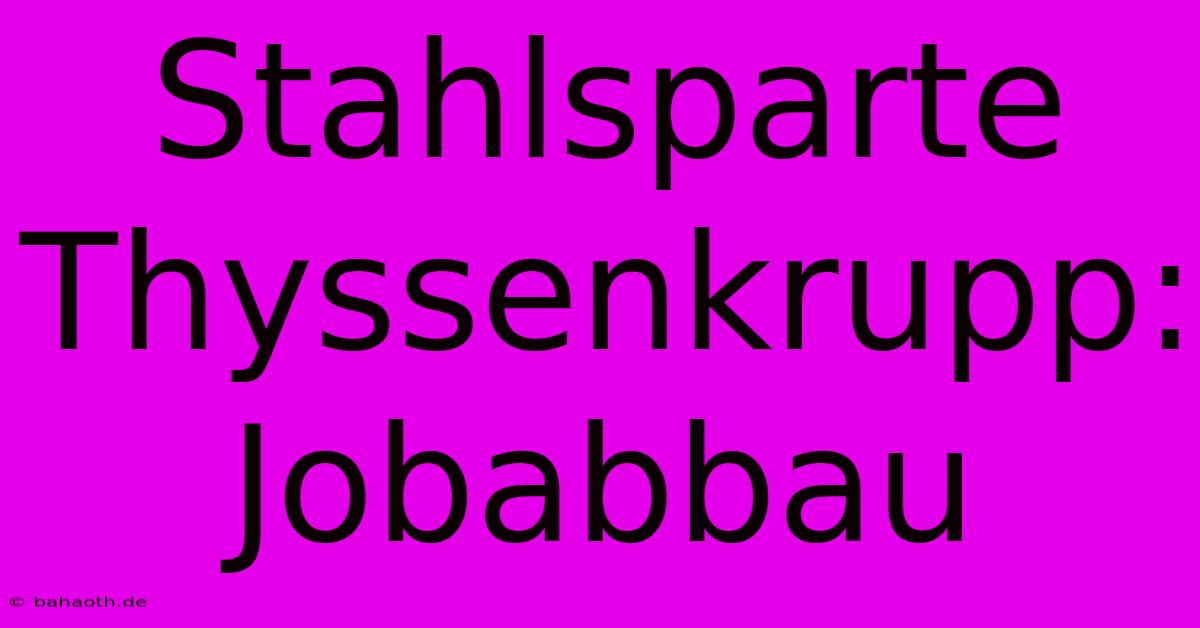Stahlsparte Thyssenkrupp: Jobabbau

Discover more detailed and exciting information on our website. Click the link below to start your adventure: Visit Best Website Stahlsparte Thyssenkrupp: Jobabbau. Don't miss out!
Table of Contents
Stahlsparte Thyssenkrupp: Jobabbau – Ein bittersüßer Abschied
Man, oh man. Writing about Thyssenkrupp's steel division job cuts is like ripping off a Band-Aid – painful, but necessary. I've been following this story for years, and let me tell you, it's a rollercoaster. Lots of ups and downs, and unfortunately, more downs lately. This ain't just about numbers on a spreadsheet; it's about real people, their families, their livelihoods. It hits close to home, you know? I've had friends affected by restructuring in similar industries. The anxiety is palpable.
The Brutal Reality of Restructuring
The recent announcements regarding job cuts in Thyssenkrupp's steel division are, frankly, devastating. We're talking about hundreds, if not thousands, of families facing uncertainty. It's a harsh reality of the modern business world, especially in industries facing global competition and technological shifts. Remember that whole thing about automation? Yeah, that's a big factor here. The industry is changing, and sadly, not everyone can ride the wave.
I remember a time, back in the day, when I worked for a company undergoing a similar situation. The air was thick with fear; whispers in the hallways, hushed phone calls, and that sinking feeling in your stomach every time your boss looked at you. It was awful. Pure, unadulterated fear. The uncertainty eats away at you.
We need to remember that these are not just statistics; these are real people with hopes, dreams, and families to support. Losing a job is not just a financial blow; it's an emotional earthquake. I've seen it firsthand. And that's why this is more than just an economic story; it’s a human story.
Understanding the Factors Behind the Job Cuts
Several factors contribute to this difficult situation. Global competition from countries with lower labor costs is a major player. Increased automation is another. Machines are replacing human workers in many areas of the steel production process, resulting in reduced labor needs. And let's not forget the impact of fluctuating raw material prices and changes in market demand. It's a perfect storm, really.
This isn't to say there's no hope. Restructuring can be painful, but it can also lead to a stronger, more efficient company. A company better positioned to compete in the long term. But that doesn't make the process any less painful for those affected. And that's what needs highlighting. We need to support those who have lost their jobs. Offer retraining and support programs and fight for better worker protections.
What Can Be Done? Practical Steps for the Affected and the Industry
For those facing job losses, seeking help from the Bundesagentur für Arbeit (Federal Employment Agency) is crucial. They offer a range of services, including job placement, retraining, and financial support. Networking is also key. Talk to former colleagues, reach out to your professional contacts – you never know where your next opportunity might come from.
For the industry as a whole, fostering innovation and collaboration is paramount. This means investing in new technologies, streamlining processes, and working together to find solutions to the challenges faced. Looking at green steel initiatives, for example, could offer new growth opportunities and perhaps even jobs.
This is a complex situation with no easy answers. But by acknowledging the human element and working together, we can navigate this difficult period and create a more sustainable future for the steel industry in Germany. This isn't just about Thyssenkrupp; it's about the future of German industry. And that's worth fighting for.

Thank you for visiting our website wich cover about Stahlsparte Thyssenkrupp: Jobabbau. We hope the information provided has been useful to you. Feel free to contact us if you have any questions or need further assistance. See you next time and dont miss to bookmark.
Featured Posts
-
Hoechststrafe Fuer Pelicot Avignon
Nov 26, 2024
-
Wiener Neustadt Polizei Einsatz Sperren
Nov 26, 2024
-
Thyssenkrupp Lopez Plant Stellenabbau
Nov 26, 2024
-
Apple Air Pods Pro 2 Black Week Preis
Nov 26, 2024
-
Thyssenkrupp Umstrukturierung Mit Jobverlusten
Nov 26, 2024
